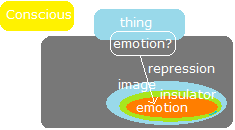The Kuriki method (the first edition in 2007) is a theory about Tourette’s syndrome (tic disorder) and obsessive-compulsive disorder to cure these diseases without medication. This theory is based on the author’s inference and interpretation regarding the structure of these diseases. Since it has been written for the psychoanalysts, reading will be difficult for people in general and it might be sometimes read erroneously. Therefore the Kuriki method must presuppose that the patient is treated by a nearby psychoanalyst, and that, between the patient and the Kuriki method, there is always the psychoanalyst. The explosion of emotional catharsis, which has strong repercussions, is done only for three seconds, once a week: beyond this rhythm, it would be an accident caused by negligence, and the psychoanalyst who is inexperienced in emotional catharsis must take responsibility for the temporary mental collapse caused by the accident. Also, to the patient who has weak capacity of logical reasoning, the psychoanalyst must explain well on the violent emotion of revenge caused by the illusory confusion between the person of the traumatic image in his head and the person in the real world.
Cure for Tourette’s syndrome (tic disorder) and OCD without medication
§30

The lower layer of tic disorder
Descriptions of some terms
Beware of the big difference of definitions of the terms and the big difference of the theoretical ideas between the Freudian psychoanalysis and the Kuriki method.
Stress of children
The bad feeling by the stress at school or the stress by too strict discipline in the family is too much obvious in the Conscious and can not remain repressed in the Unconscious. These stresses are constant objects of the Conscious. As long as the child thinks in the head; “I don’t like it.”, there will be no repression. Too obvious social or physical stresses can not be a direct cause of tic disorder. As the onset of a tic disorder is often at the age of three, school stress can not be the cause of it. The causes of neurosis are disagreeable sexual, genital or bodily judgments of everyday, which are not expressed in the Conscious; such as nudity of a family member, skin contact, etc. Expression of judgment in the Conscious, it is emotion. The disagreeable emotion is a bodily expression of a disagreeable judgment in the Conscious, therefore disagreeable emotion is a bodily sensation. The repression of the expression of bodily sensation of disagreeable judgment in the lower layer and the repression of disagreeable bodily sensations in the upper layer have a similarity.
The term “stress” is now used as being deviated from the original meaning. The use of this term is avoided in the descriptions of the Kuriki method.
Mass of emotion consists of a traumatic image, an insulator and a potential emotion. Like an onion, or a matryoshka (Russian doll), nesting (nested strucure) is possible: i. e., inside the traumatic image, there can be another traumatic image. The patient sees the internal image at the moment of a catharsis against the external image of the mass of emotion. The traumatic image at the age of three years will be only logically inferred with the factual context. It is a vague image, which is in the center of the mass of emotion.
When a disagreeable judgment for something repeated every day causes an accumulation of potential emotion under the insulator, the image of this thing can be called psychological trauma. Psychological trauma does not designate the mass of emotion, but an image. Unless it is a PTSD (post-traumatic stress disorder), in general, the psychological trauma is not obvious to the patient with tic disorder as a trauma, which would be extremely disagreeable. With the repressed judgment, the trauma must rather be a pleasant image. Even if they are not traumatic for adults, there are very disagreeable things for children, and when the judgment of something disagreeable is repressed and the mass of emotion has been formed, the image of this thing will be a psychological trauma. Repression is the repression of a judgment disagreeable, and it is not the repression of the traumatic image. The traumatic images are always visible in the memory.
The insulator is a function of repression. The thickness of the insulator is congenital: it is the predisposition of each patient to Tourette syndrome. In case where the insulator is too open by an excessive catharsis, the patient has to wait until the insulator closes again slowly at the speed of molluscs. (For 10 minutes?)
Too strong Catharsis is prohibited.
